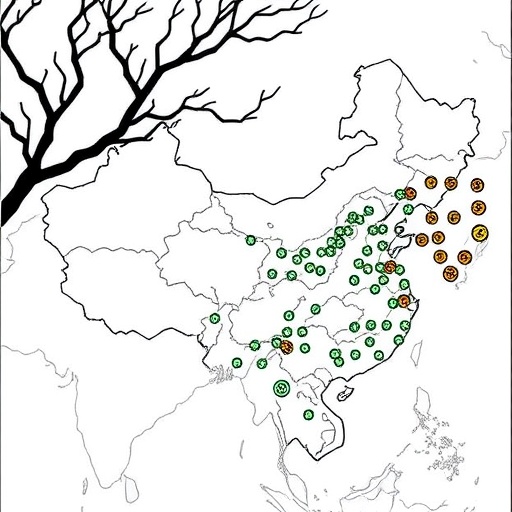In the rapidly evolving field of forensic genetics, the precision of kinship testing remains paramount for legal and investigative purposes. Recent research spearheaded by Hu, Dai, Wang, and their colleagues sheds new light on how population substructure within multi-ethnic regions of China can significantly influence the outcomes of kinship analyses. Their groundbreaking study, soon to be published in the International Journal of Legal Medicine, meticulously dissects the complexities introduced by genetic diversity and subpopulations, revealing challenges that may upend traditional forensic methodologies.
China, with its vast geography and multitude of ethnolinguistic groups, presents a unique genetic landscape. Populations in different regions often harbor subtle but consequential genetic distinctions. These distinctions, although negligible in broader population genetics, become critically important when forensic experts attempt to establish biological relationships through kinship testing. The foundational principle of many kinship analyses assumes a relatively homogeneous genetic background. However, in multi-ethnic areas where intricate population substructures prevail, this assumption does not hold, jeopardizing the accuracy of forensic conclusions.
Hu and colleagues embarked on their investigation by collecting and analyzing genetic data from diverse ethnic groups residing in several provinces known for their multi-ethnic populations, including Yunnan, Guangxi, and Guizhou. Utilizing both autosomal short tandem repeat (STR) markers and mitochondrial DNA sequences, their comprehensive approach allows for a multi-faceted understanding of how genetic variability influences kinship estimates. Their methodological rigor ensures that subtle population stratifications are neither overlooked nor underestimated.
The study delves into the ramifications of population substructure, highlighting how allele frequency variations across subpopulations affect the statistical probabilities used in kinship determinations. Standard procedures typically rely upon reference allele frequencies assumed to be representative of the individual’s population. However, in ethnically diverse regions, these reference distributions are diluted or inaccurate, leading to errors in likelihood ratios. Such distortions can result in false inclusions or exclusions, with severe implications in forensic casework, where kinship evidence often guides legal decisions.
Moreover, the researchers explored the extent to which different ethnic groupings diverge genetically and the impact of such differentiation on kinship testing outcomes. Their findings illuminate a pattern of significant genetic heterogeneity within administrative boundaries that traditionally grouped these populations under a broader category. This intra-regional divergence underscores the dangers of applying generic genetic databases without accounting for local ethnic substructures.
In addition to autosomal genetic markers, mitochondrial DNA (mtDNA) and Y-chromosomal markers were analyzed to provide lineage-specific insights. mtDNA, inherited maternally, and Y-chromosome haplotypes offer specialized information about maternal and paternal ancestries, respectively. The study’s integration of these markers adds depth to the kinship analysis, enabling more nuanced distinctions between related individuals and unrelated members of genetically distinct subpopulations. This multimarker approach enhances forensic validity by compensating for the limitations of single-marker analyses.
The implications of this study are profound for forensic practice in China’s ethnically complex regions, necessitating urgent revisions in kinship testing protocols. The authors advocate for the development of more refined population-specific reference databases that accurately capture local allele frequencies and haplotype distributions. Such databases are critical for improving the precision of kinship analyses and reducing the risk of misinterpretations caused by population substructure effects.
Beyond its forensic applications, the study also contributes rich insights to population genetics and anthropological research. Understanding genetic substructures in multi-ethnic contexts informs broader discussions on human migration, historical population dynamics, and the evolutionary relationships among China’s diverse ethnicities. These findings suggest that genetic heterogeneity is more intricate than previously understood, urging researchers to reconsider simplified models of population homogeneity.
While technological advances have improved forensic DNA typing, the study emphasizes that bioinformatics and statistical evaluation must evolve in tandem. The researchers call attention to the necessity for innovative computational methods capable of modeling complex population structures accurately. This is particularly relevant as forensic investigations become increasingly globalized, involving multinational datasets and individuals from diverse genealogical backgrounds.
Furthermore, the study highlights the ethical and legal ramifications of population substructure influences on kinship testing. Incorrect kinship results not only undermine judicial integrity but can also lead to social and familial turmoil. Ensuring the scientific robustness of forensic evidence becomes a matter of justice, requiring interdisciplinary collaboration between geneticists, statisticians, legal experts, and ethicists.
The researchers also underscore the importance of ongoing education and training for forensic practitioners on the nuances of population genetics. Familiarity with genetic stratification and its consequences must be incorporated into forensic curricula, ensuring that experts appreciate and mitigate these factors during casework. This proactive approach will help bridge the gap between scientific discovery and practical forensic application.
In light of their findings, Hu et al. propose the establishment of a national initiative aimed at systematically cataloging ethnic-specific genetic variation across China. Such an endeavor would facilitate the creation of a centralized, dynamic repository serving forensic, medical, and anthropological communities alike. Standardizing such data would enable cross-laboratory consistency and foster international cooperation in forensic genetics.
Their profound work shines a spotlight on a hitherto underappreciated obstacle within forensic genetics, particularly in polyethnic settings. The research serves as a clarion call for reevaluation and refinement of existing forensic tools and standards to embrace the complexities of human genetic diversity. As forensic science advances, acknowledging and integrating population substructure phenomena will be indispensable for maintaining accuracy, fairness, and public trust.
In conclusion, the study spearheaded by Hu, Dai, Wang, and colleagues fundamentally challenges the assumptions underlying conventional kinship testing in multi-ethnic regions of China. By meticulously dissecting the influence of population substructure, they have paved the way for more precise, equitable, and scientifically sound forensic methodologies. Their innovative approach and striking findings promise to resonate broadly across forensic genetics, population biology, and legal medicine, charting a new course for research and practice in diverse genetic landscapes.
Subject of Research: The impact of population substructure on the accuracy of kinship testing in multi-ethnic areas of China.
Article Title: Population substructure affects kinship testing in multi-ethnic areas of China.
Article References:
Hu, Y., Dai, X., Wang, H. et al. Population substructure affects kinship testing in multi-ethnic areas of China. Int J Legal Med (2025). https://doi.org/10.1007/s00414-025-03572-5
Image Credits: AI Generated
Tags: autosomal short tandem repeat markersbiological relationship establishment difficultiesethnolinguistic groups genetic differencesforensic accuracy in diverse populationsforensic genetics and population substructuregenetic landscape of ChinaHu Dai Wang research findingskinship testing challenges in Chinalegal implications of kinship analysismulti-ethnic regions genetic diversitypopulation genetics in kinship testingtraditional forensic methodologies issues





